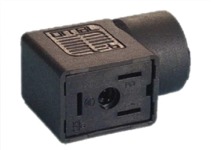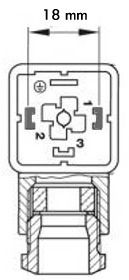Guide to DIN 43650 solenoid valve connectors Major Electronix handles a wide range of DIN 43650 / ISO 4400 (EN 175301-803) Solenoid Valve Connectors. Various options in modifying the connectors include indicator lights, surge suppression, and molded cable. Major can meet specific requirements for manufacturers such as Hirschmann, HTP, MURR, and Omal. Major stocks field attachable and molded solenoid valve connectors for immediate delivery, while also handling custom connector assemblies. ISO 4400 refers to the standards set by the International Organization for Standardization, which are made for electrical connectors. DIN 43650 refers to the set of standards made by DIN (Deutsches Institut fur Normung), which is the German standard setting organization. Din 43650 is now known as the EN 175301-803 standards, which refer to these types of connectors. Other names for DIN 43650 connectors include MPM or sugarcube connectors. These solenoid valve connectors come in three versions: Form A, Form B or Form C. They have met various overvoltage protection requirements and are made to function within certain voltage limits. GasketsThere are three gasket options available for the DIN connectors: NBR Profile, NBR Flat or EPDM Flat. Each of the different gaskets will has different characteristics, mainly based on the material from which they are made. NBR rubber is also known as nitrile rubber. NBR is an oil resistant material, which includes both mineral and vegetable oil. EPDM rubber does not have much resilience against oils, but it does stand up well to ozone, heat and weather. Both materials are satisfactory against basic diluted acids and alkalines. Most of the gaskets available are from HTP and Hirschmann. Separate gaskets are also available for most of the male DIN connectors. Thread TypesDIN 43650 solenoid valve connectors will have different thread types for the cable entry, depending on the form. Form A connectors are currently available in PG 9, PG 11, M16, or 1/2" NPT thread sizes. Form B features PG 9 or 1/2" NPT threads, while Form C connectors are only available with PG 7 thread. M16 is a metric thread type, which globally is the most commonly used type. The number refers to the nominal diameter in millimeters. PG stands for Panzergewinde and refers to German standards. PG has a bigger thread angle but a lower thread depth than metric or NPT. NPT stands for National Pipe Thread and is an American standard. Unlike metric or PG, these threads are tapered, which helps form a seal. Pin SpacingPin spacing refers to the distance between pins #1 and #2. Each form has different pin spacing, and the pin type also changes depending on the form. Form A connectors have "U" shaped pins facing inwards with an 18 mm pin spacing. Form B connectors have 2 different pin spacings: 10mm & 11mm. 11mm connectors will have 3 flat blade contacts and are the industry standard. 10mm connectors will have 1 flat blade and 2 U shaped pins pointing outward. Form C connectors have flat blade pins with 8mm or 9.4mm (industry standard) pin spacing. Diagrams of the pin spacing are pictured at the top of the page to better visualize their design. Comparison ChartsEach of these different versions have characteristics which set them apart from the other two, which are listed in following comparision charts: Connector OptionsDIN 43650 connectors can be customized with several options, which are listed in the chart below:
|
||||||||||||||||||











